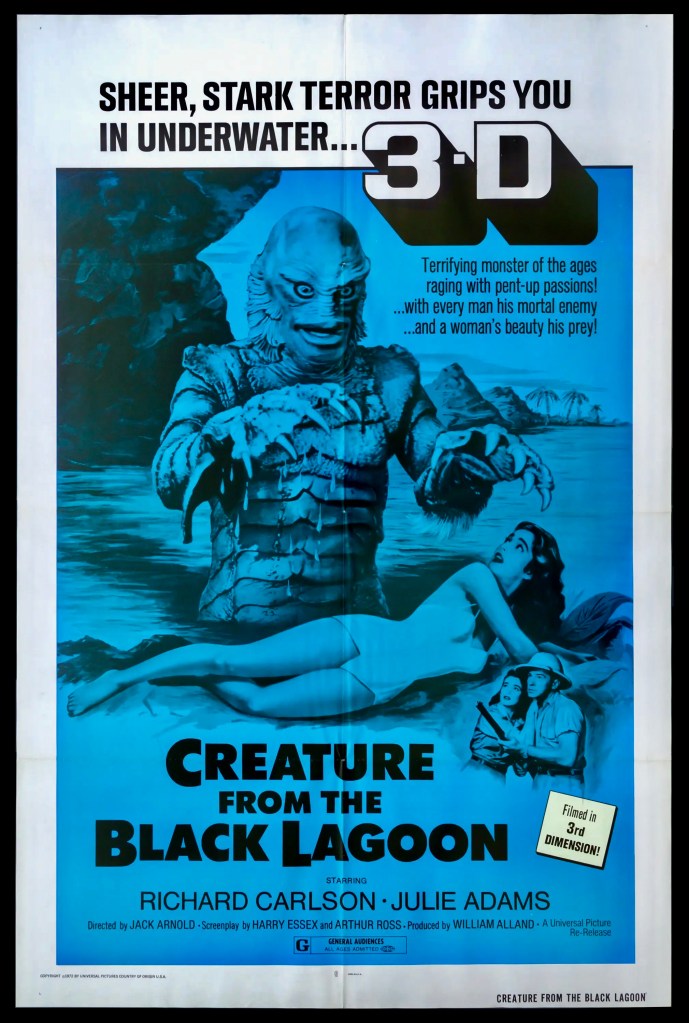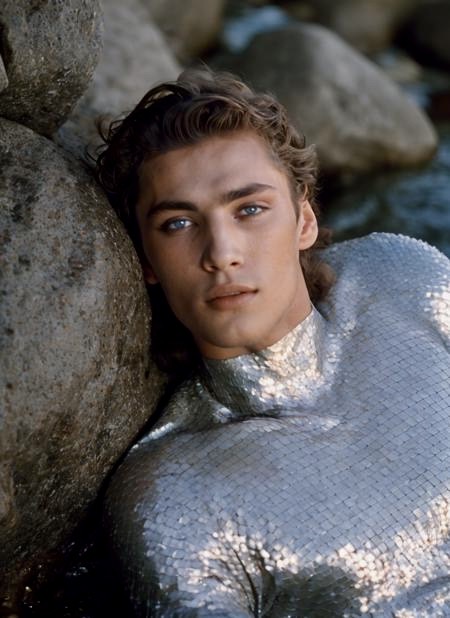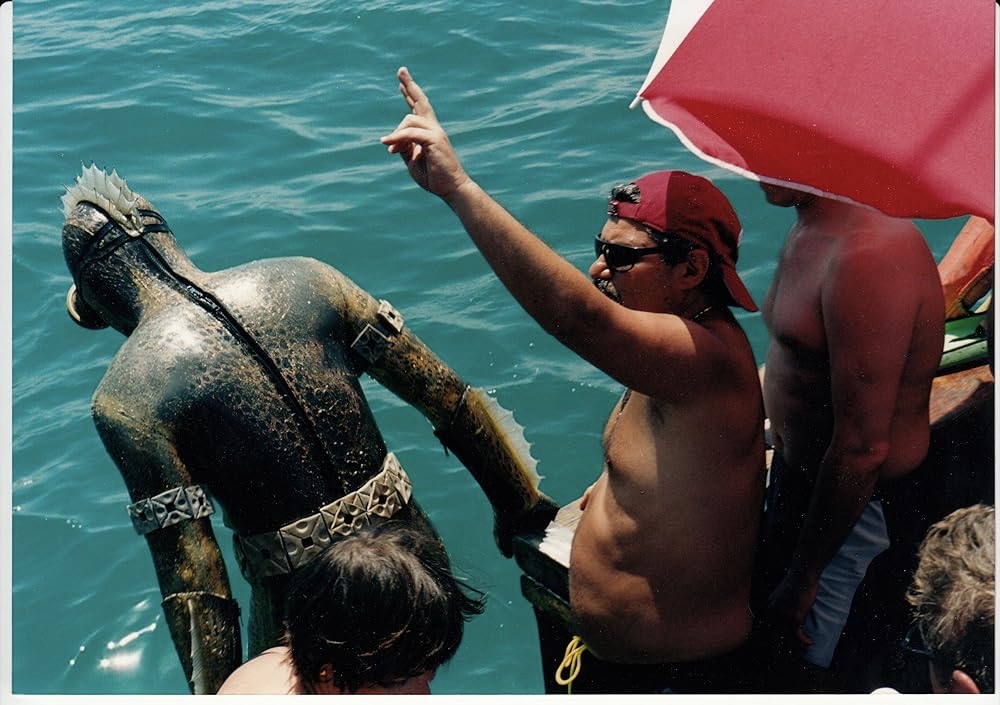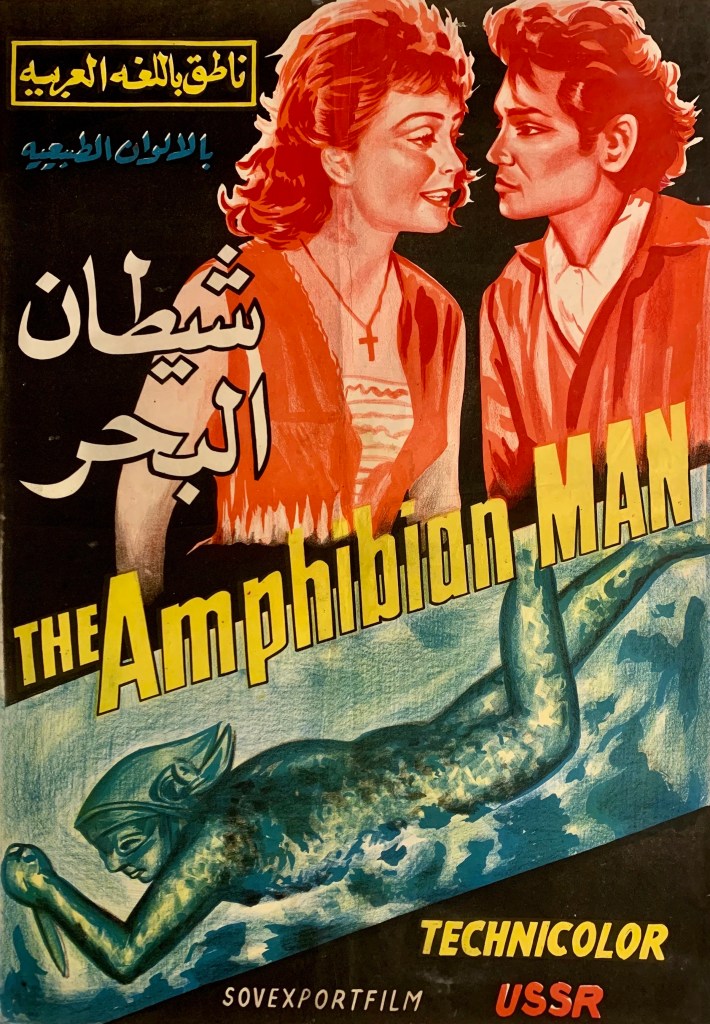
Science fiction and fantasy films have always been a popular staple of Russian cinema but, during the first half of the 20th century, very few of these genre films found theatrical distribution in the U.S. Among the handful that did make to American screens are Yakow Protazanov’s Aelita, the Queen of Mars (1924), Vasily Zhuravlyou’s Cosmic Journey (1936), Planeta Bur aka Planet of Storms (1962), which producer/director Roger Corman raided twice, using footage from it for Voyage to the Prehistoric Planet (1965) and Voyage to the Planet of Prehistoric Women (1968), and Ilya Muromets (1956), an epic fairy tale adventure from director Aleksandr Ptushko that was released in an edited, English-dubbed version entitled The Sword and the Dragon. Some Russian fantasy titles later popped up on American television and second-run houses in poor quality English language dubs like Sampo aka The Day the Earth Froze (1959) but my all-time favorite from this period is Chelovek-Ambibiya (English title: Amphibian Man, 1961), co-directed by Vladimir Chebotaryov and Gennadiy Kazqanskiy.
Based on a novel by fantasy writer Alexander Belyaev, often referred to as the “Russian Jules Verne,” Amphibian Man was an immensely popular film with Soviet teenagers when it was first released though government authorities considered it too exotic and atypical of their national cinema. It also probably annoyed them when the film won the prestigious Silver Spacecraft award at the 1963 Trieste Science Fiction Festival for its “poetic qualities” (it shared the prize with Roger Corman’s X: The Man with the x-Ray Eyes). Unfortunately, Amphibian Man was difficult to see in the U.S. for many years in its original form and I only caught up with it in the 1980s when I saw an edited, English-dubbed 16mm print of the movie from Kit Parker Films. Even in this compromised version, the visual design and imaginative narrative were a revelation and it puzzled me that the film was not better known here.
Although Belyaev published his original novel in 1928, it would be hard to deny similiarities between Amphibian Man and the 1951 3-D cult sci-fi/horror hit Creature from the Black Lagoon. Both stories deal with an underwater creature who falls in love with a beautiful woman. The difference is that the Black Lagoon lurker is a lustful prehistoric creature and a threat to humans while the title character of Amphibian Man (played by Vladimir Korenev) was once a normal young man who was transformed into an aquatic being by Dr. Salvator (Nikolai Simonov), his scientist father.

In explanation to Olsen (Vladlen Davydov), a sympathetic newspaper reporter, Dr. Salvator says, “As a young boy, he contracted an incurable lung disease. In a desperate attempt to save him I replaced his lungs with the gills of a shark. That risky operation was a success. That’s when I got the idea of creating an underwater republic.” Salvator’s dream of a future utopia under the sea where everyone will be happy and equal is a secondary theme in the movie but the main emphasis is on Ichtyandr, the amphibian hero, and his romance with Guttiere (Anastasiya Vertinskaya), a shopkeeper’s daughter.
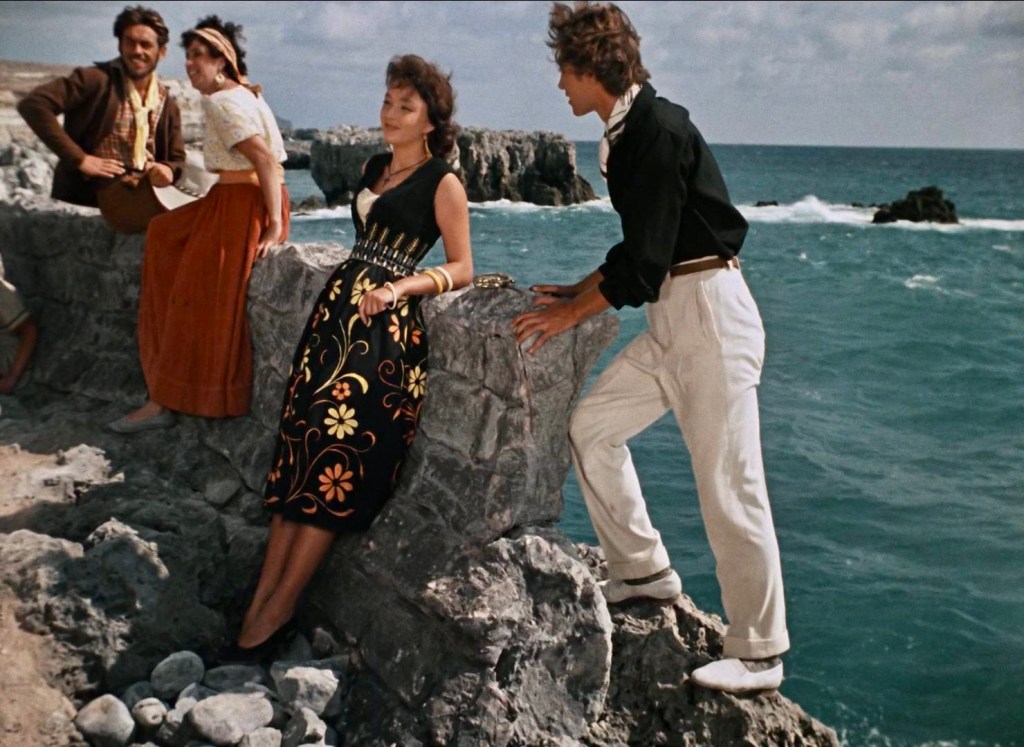
The curious thing about Ichtyandr is that he looks like a perfectly normal human being but when he is out surveying his underwater domain he wears a protective costume (flippers, a tight silver lame outfit and a spiked helmet/face mask that makes him appear fishlike). Sightings of Ichtyandr create panic among the local fishermen and pearl divers, earning him the moniker “the sea devil.” Yet once, he catches a glimpse of the lovely Guttiere, he falls in love and longs to live with her on dry land among the humans.

Ichtyandr’s pursuit of Guttiere, however, appears to be doomed from the start. Her father Baltazar (Anatoliy Smiranin) has promised her to Don Pedro (Mikhail Kozakov), a scheming, greedy merchant who decides to capture Ichtyandr and force him to work for free, harvesting pearls from the ocean’s body. The story takes several twists and turns along the way and, while the romance between Ichtyandr and Guttiere is chaste and idealized, Amphibian Man displays some darker aspects and the fadeout is downbeat without the expected fairy tale ending of something like Walt Disney’s 1991 version of Beauty and the Beast or The Little Mermaid (1989).
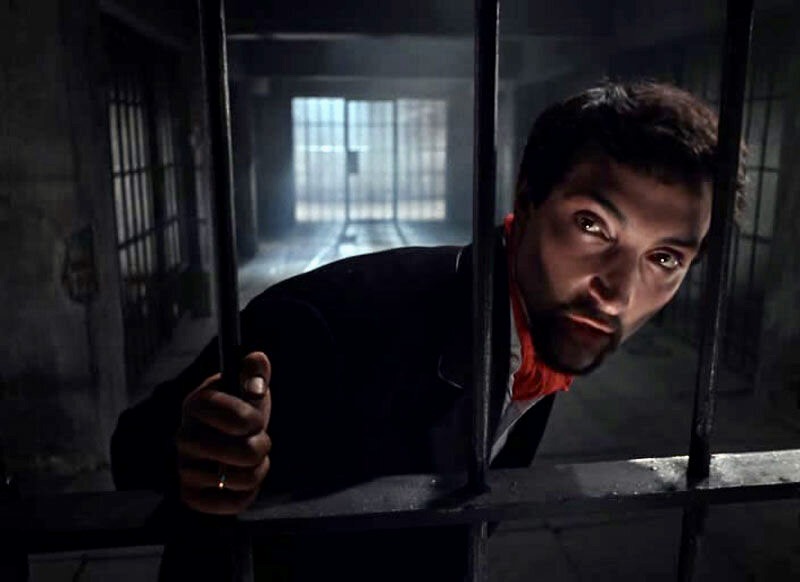
Amphibian Man is absolutely fine for children but adult viewers will be struck by the film’s beautifully rendered fantastical qualities and the stunning production design by Vsevolod Ulitko and Tamara Vasikovskaya. The eerie otherworldly music score by Andrey Petrov has a lush, haunting quality (the soundtrack album was quite popular) and the narrative is briskly paced and consistently eye-pleasing (the cinematography is by Eduard Rozovsky. Ichtyandr’s stylized undersea kingdom is littered with chunks of red coral, seaweed, large seashells that can be played like instruments and marine bric-a-brac while the interior of Dr. Salvator’s cavernous residence (which sits on a rocky cliff overlooking the sea) is just as futuristic and visionary as Captain Nemo’s submarine in Jules Verne’s 20,000 Leagues Under the Sea. I especially love the huge living room portal that looks out over the ocean floor and allows the doctor to view his son swimming among the other aquatic species.
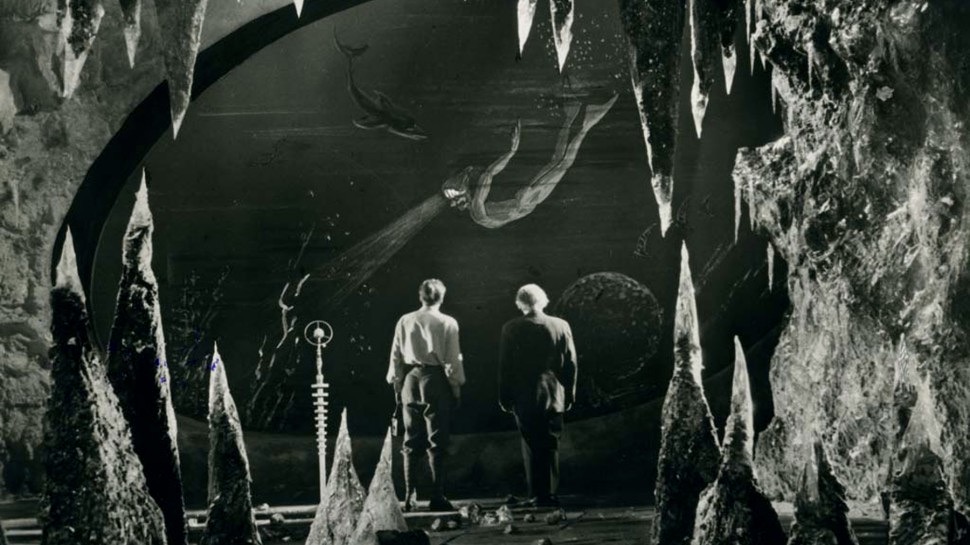
There are also some odd but amusing diversions from the main storyline occasionally such as several musical numbers (one set in a jazzy nightclub, one performed by a folk singer in the street), and a gypsy-like dance sequence among the local peasants with Guttiere teaching Ichtyandr some fancy steps. The setting of Amphibian Man is also never actually identified but it appears to be set in Cuba or Mexico or some south-of-the-border country where the men wear sombreros and the weather is hot and sunny (Much of the movie was actually shot in the Ukraine, off the coast of the Crimean Peninsula).
One of the first Russian films to be partially filmed underwater, Amphibian Man used a crew that were mostly experienced swimmers and athletes. Lead actor Vladimir Korenev had to train to swim underwater for several scenes (he also had a body double for the more challenging action scenes) and actress Anastasiya Vertinskaya had to be given oxygen every forty seconds or so during her under-the-sea sequences.
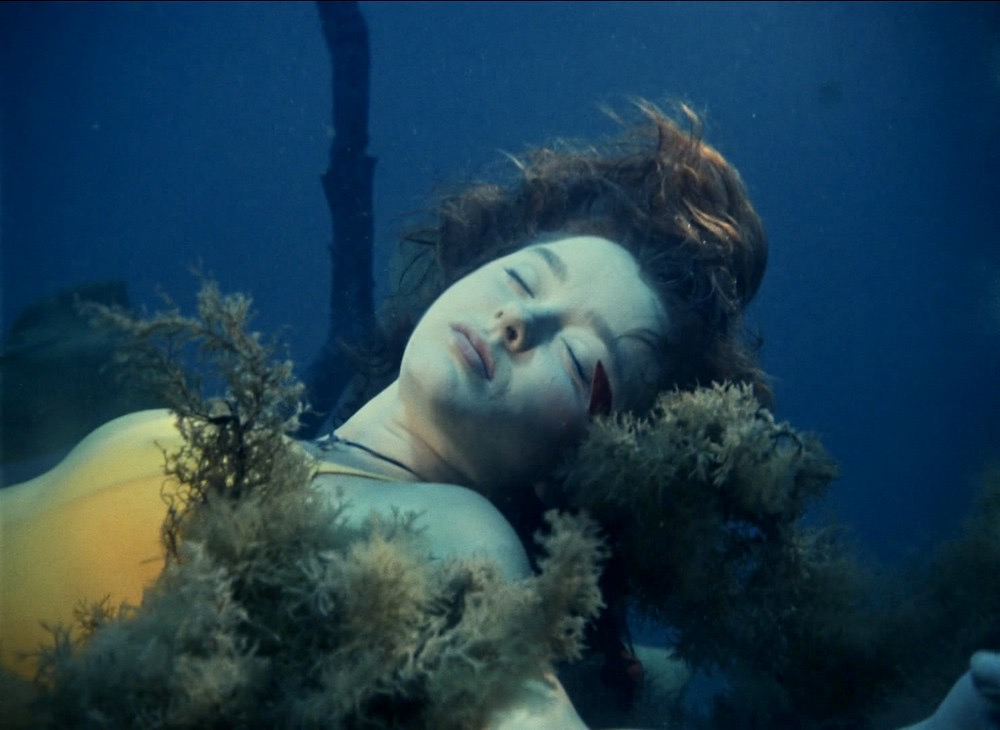
Korenev certainly had the necessary mixture of sensitivity and male beauty for the title character (and it propelled him to stardom) but it is Vertinskaya as Guttiere, who is the most famous performer from this movie, and she would go on to become one of Russia’s most acclaimed actresses, appearing as Ophelia in Grigoriy Kozintsev’s 1964 film adaptation of Shakespeare’s Hamlet and as Princess Bolkonskaya in Sergei Bondarchuk’s magnificent 1965 movie version of Leo Tolstoy’s War and Peace.

In recent years Quentin Tarantino has emerged as a fan and admirer of Amphibian Man and some viewers will notice that besides surface similarities to Creature from the Black Lagoon, the movie is also a precursor to Guillermo del Toro’s 2017 Oscar-winning fantasy The Shape of Water, the story of a relationship between a lonely female janitor and an amphibian creature being used for government experiments. The main difference is that the human female/sea creature romance in del Toro’s film is decidedly sexual in nature and the movie is much more violent, nightmarish and surreal than the delicate, poetic fantasy of Amphibian Man.
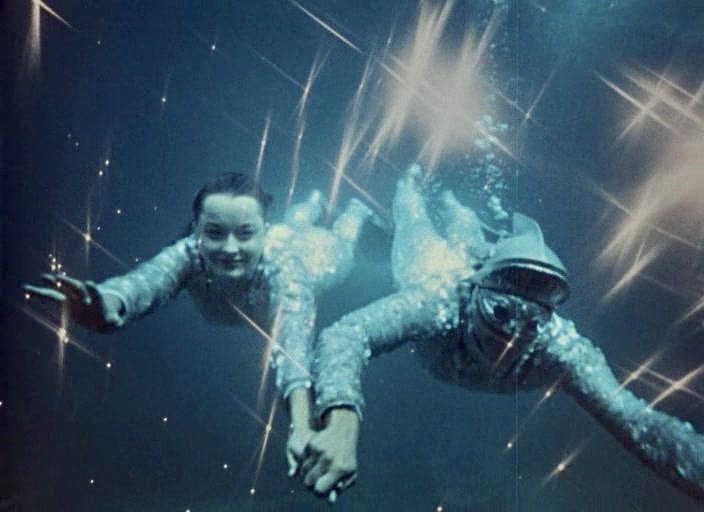
Even though Amphibian Man was made after Nikita Khrushchev rose to power in 1956 and began initiating a series of social, political and economic reforms in reaction to Stalin’s brutal regime, the movie is mostly free of any propaganda or ideology that would have been much more overt in Russian films of the fifties. The only thing close to any social/political commentary is Dr. Salvator’s altruistic visionary. “The unfortunate people should be helped not by a politician or a newspaper man but by a scientist,” he states at one point. “I will lead the poor to a land of abundance where no one will oppress them – in the ocean. At the bottom of the ocean, they’re neither poor nor wealthy. Everyone will be free and happy there.”
“Will it be a republic of the drowned?” Olsen asks sarcastically. The reporter is decidedly less optimistic about mankind and suggests that the common people would have no interest in an utopian underwater society. “Human nature won’t change. People will miss the land.”
For years Amphibian Man was only available in inferior bootlegs and poor transfers but in August 2001, Ruscico (the Russian Film Council) released the film on DVD through the distribution of Image Entertainment. Amphibian Man was presented in a beautifully restored print in the correct aspect ratio and viewable in a number of audio/subtitle options. Some of the extras include some short featurettes on the making of the movie. The film is certainly overdue for a Blu-ray upgrade but this is still the best option for seeing this long overlooked but superb example of Russian fantasy filmmaking.
Other links of interest:
https://almaty.theatrehd.com/en/people/vladimir-korenev
https://neweastcinema.pitt.edu/amphibian-man/
https://peoplepill.com/i/gennadi-kazansky


